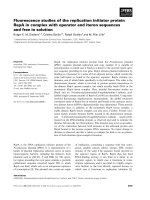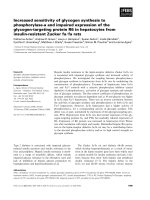Characterisation of the BRCT DBL protein ECT2 in cell cycle regulation
Bạn đang xem bản rút gọn của tài liệu. Xem và tải ngay bản đầy đủ của tài liệu tại đây (5.48 MB, 170 trang )
CHARACTERISATION OF THE BRCT/DBL PROTEIN
ECT2 IN CELL CYCLE REGULATION
CHENG SHI YUAN
(BSc (Physiology), NUS)
A THESIS SUBMITTED
FOR THE DEGREE OF DOCTOR OF PHILOSOPHY
DEPARTMENT OF PHYSIOLOGY
FACULTY OF MEDICINE
NATIONAL UNIVERSITY OF SINGAPORE
2008
i
ACKNOWLEDGEMENTS
I would like to express gratitude to my supervisors, A/Prof Wong Meng Cheong, Dr
Zhu Congju, Division of Medical Sciences, National Cancer Centre and A/Prof Lee
Chee Wee, Department of Physiology, Faculty of Medicine, National University of
Singapore for their guidance and patience, and the opportunity to work on this project. I
wish to especially acknowledge Dr Zhu Congju for his immediate supervision and for
being a mentor in many ways.
I wish to thank my fellow lab-mates from the Brain Tumour Research Laboratory,
Tingting, Siaw Wei, Khong Bee, and Christine at the National Cancer Centre for their
support and understanding. Also to all my friends and colleagues who have helped in one
way or another: Chun Kiat, Yee Peng, Aik Seng, Hui Hua and Kia Joo.
I wish to thank the Singapore General Hospital for recognising the work in this thesis and
for awarding me with the Young Investigator’s Award at the Annual Scientific Meeting
2007.
I would like to thank the National Medical Research Council for awarding me the
Medical Scientist Fellowship. This work would not be possible without generous funding
from the Biomedical Research Council.
ii
DEDICATION
This thesis is dedicated to my parents, who have supported me through the years and to
my husband Bernard for his encouragement. Without them, completion of this thesis
would have been impossible.
iii
TABLE OF CONTENTS
ACKNOWLEDGEMENTS
TABLE OF CONTENTS
SUMMARY
LIST OF FIGURES
LIST OF ABBREVIATIONS USED
CHAPTER 1: LITERATURE REVIEW
1.1 Malignant Gliomas
1.1.1 Grading of gliomas
1.1.1.1 Issues encountered in the proper classification of gliomas
1.1.1.2 Criteria for selecting candidate genes as glioma biomarkers
1.1.2 Temozolomide in the treatment of malignant gliomas
1.1.2.1 Chemo-resistance to TMZ in gliomas
1.1.2.2 Current strategies to overcome TMZ resistance
1.2 Cell cycle control and cancer
1.2.1 Cyclins and cyclin-dependent kinases
1.2.2 CDK inhibitors
1.2.3 G1 control and cancer
1.2.3.1 Cyclin deregulation
1.2.3.2 Regulation of the p27
Kip1
CDK inhibitor
1.2.3.3 Growth factor signalling in cancer
1.2.3.4 Ras GTPase signalling in cancer
1.2.3.5 Rho GTPase signalling in cancer
1.3 Guanine nucleotide exchange factors
1.3.1 Structure and function of the Dbl proteins
1.3.1.1 The DH domain
1.3.1.2 The PH domain
1.3.2 Dbl proteins in cancer
i
iii
vii
ix
xi
1
1
1
2
4
5
6
9
11
12
14
16
17
19
21
23
25
29
30
31
32
33
iv
CHAPTER 2: INTRODUCTION
2.1 Isolation of the Ect2 proto-oncogene
2.2 Cell cycle-dependent regulation of Ect2
2.3 N-terminal domains of Ect2 are similar to cell cycle regulatory
proteins
2.4 Cellular functions of Ect2
2.4.1 Ect2 is required for cytokinesis
2.4.2 Ect2 induces cellular transformation
2.4.3 Regulation of epithelial cell polarity and migration by Ect2
2.5 Scope of this study
CHAPTER 3: MATERIALS AND METHODS
3.1 Reagents and chemicals
3.2 Plasmids and constructs
3.3 Cell culture and treatment
3.4 Real-Time Reverse Transcription (RT)-PCR
3.5 FACS analysis of DNA content
3.6 Western blot analysis
3.7 Chromatin fractionation assay
3.8 Cell viability assay
3.9 Rho activity assay
3.10 mRNA stability and half-life
3.11 Cell invasion assay
3.12 Dual-luciferase reporter assay
3.13 Tritiated thymidine ([
3
H]TdR) incorporation
37
37
37
41
42
42
45
48
50
52
52
52
53
53
54
55
55
56
57
57
57
58
58
v
CHAPTER 4: RESULTS
4.1 The role of full-length Ect2 in cell cycle regulation
4.1.1 Ect2 suppression-induced G
1
arrest leads to decreased DNA synthesis
4.1.2 Ect2 suppression inhibits G
1
/S progression in re-stimulated quiescent
human glioma cells
4.1.3 Ect2 alters the levels of CDK inhibitor p27
Kip1
and pRb hyper-
phosphorylation
4.1.4 Effects of Ect2 over-expression on p27
Kip1
4.1.5 Ect2 over-expression drives quiescent cells through G
1
/S
4.1.6 Mechanism of Ect2-mediated p27
Kip1
suppression
4.1.6.1 Ect2 regulates p27
Kip1
transcript stability
4.1.6.2 Ect2 regulates p27
Kip1
through the proteasome
4.1.7 Ect2 promotes G
1
/S progression through Rho GTPase
4.1.8 Effects of truncated Ect2 mutants on p27
Kip1
and Rb phosphorylation
4.1.9 Ect2 is found in the cytoplasm of quiescent human glioma cells
4.2 Ect2 as a potential marker and therapeutic target of gliomas
4.2.1 Ect2 promotes glioma cell invasion in vitro
4.2.2 Ect2 is required for glioma cell proliferation and viability
4.2.3 Ect2 down-regulation decreases viability of a TMZ- and γ-irradiation
resistant human glioma cell line
CHAPTER 5: DISCUSSION
5.1 Role of Ect2 in regulating G
1
/S progression
5.1.1 Ect2 is a key regulator of G
1
/S progression
5.1.2 Role of Ect2 in regulating G
1
/S progression is key to its oncogenecity
5.1.3 Ect2 is the exchange factor regulating RhoA activity in cell cycle
progression
5.1.4 Full-length Ect2 modulates p27
Kip1
tumour suppressor, with DH domain
being the functional motif
5.1.5 Synergism between Ect2 and other signalling pathways in transformation
5.2 Potential clinical applications of Ect2
60
60
60
65
67
71
73
75
75
80
80
84
86
89
89
91
91
96
96
96
98
99
100
103
103
vi
CHAPTER 6: FUTURE WORK
6.1 Regulation of G
1
/S progression by Ect2
6.1.1 Regulation of p27
Kip1
by Ect2
6.1.2 Ect2 and Cyclin E-CDK2 activity
6.1.3 Synergism between Ect2 and Ras/MAPK signalling in transformation and
oncogenesis
6.2 Validating clinical relevance and potential applications of Ect2
6.2.1 Ect2 over-expression and glioma invasion
6.2.2 In vivo models for validation of in vitro findings
6.2.2.1 Ect2 over-expression and oncogenesis
6.2.2.2 Validating Ect2 as a potential therapeutic target
6.2.2.3 The use of RNAi targeted against Ect2 in glioma therapy
6.2.3 Correlations between Ect2 and p27
Kip1
in clinical samples
REFERENCES
APPENDICES
1. Manuscript submitted to the journal J Biol Chem
2. Abstract of scientific work presented for the Young Investigators Award at
Singapore General Hospital Annual Scientific Meeting 2007
106
106
106
106
107
108
108
109
110
111
112
113
114
vii
SUMMARY
Ect2 is a member of the Dbl family of proto-oncogenes and exhibits exchange
activity for Rho-GTPases. It is over-expressed in dividing cells and tumours such as
gliomas, and thus implicated in oncogenesis. However, a mechanism that underpins Ect2
oncogenecity is not clear. Firstly, in this study, analysis of Ect2 function in glioma cells
reveals a role in G1/S progression. Ect2 suppression by siRNA abrogates G1/S
progression in quiescent glioma re-stimulated with serum, and is accompanied by high
levels of the CDK inhibitor p27
Kip1
and reduced Rb hyper-phosphorylation. In contrast,
Ect2 over-expression in quiescent cells suppresses p27
Kip1
and induces serum-
independent DNA synthesis. Ect2 mediates p27
Kip1
suppression through decreased
mRNA half-life and protein degradation; inhibition of the proteasome activity abrogates
p27
Kip1
reduction. Furthermore, Ect2 mediates Rb hyper-phosphorylation through RhoA
activation. Ect2 over-expression increases RhoA activation, which is underscored by
increased association between Ect2 and activated RhoA. These findings indicate that Ect2
oncogenecity may be linked to its RhoGEF function in regulating the G
1
/S progression
through degradation of the key CDK inhibitor p27
Kip1
. In addition, the DH domain of
Ect2 is demonstrated to be the minimum requirement for the inactivation of the p27
Kip1
tumour suppressor.
Secondly, a functional relationship between Ect2 over-expression and glioma
grading is established. Ect2 over-expression promotes glioma cell invasion, and it is
likely that Ect2-mediated G1/S progression can contribute to increased cell proliferation
viii
associated with high grade gliomas. In addition, down-regulation of Ect2 markedly
inhibits glioma cell proliferation and clonogenecity in both TMZ-sensitive and –resistant
cell lines. Taken together, these results validate the use of Ect2 as a biomarker for
accurate glioma grading, as well as forming the basis for Ect2 as a candidate for targeted
therapy in the treatment of gliomas.
ix
LIST OF FIGURES
Figure 1.1 Proposed mechanism for TMZ-induced cytoxicity
Figure 1.2 Phases of the cell cycle and cyclin-CDK complexes driving each phase
Figure 1.3 Events involved in the regulation of G
1
/S progression
Figure 1.4 Simplified scheme of Ras and Rho signaling events cumulating in
cellular transformation and tumourigenesis
Figure 2.1 Structure of Ect2 gene
Figure 2.2 Alignment of Ect2 BRCT domains with other BRCT-containing
proteins
Figure 2.3 Alignment of Ect2 with other Dbl proteins
Figure 4.1 Down-regulation of Ect2 is accompanied by accumulation in G
1
Figure 4.2 Ect2 down-regulation decreases DNA synthesis
Figure 4.3 Ect2 down-regulation delays S phase progression
Figure 4.4 Optimization of siRNA transfection during starvation in U118 glioma
cells
Figure 4.5 Ect2 is required for G
1
/S progression
Figure 4.6 Regulation of cell cycle proteins by Ect2 during G
1
/S progression
Figure 4.7 Ect2 over-expression suppresses p27
Kip1
and promotes Rb hyper-
phosphorylation
Figure 4.8 Ect2 over-expression induces serum-independent G
1
/S progression
Figure 4.9 p27
Kip1
mRNA is lower in cells over-expressing Ect2
Figure 4.10 Ect2 does not modulate p27
Kip1
promoter activity
Figure 4.11 Ect2 modulates p27
Kip1
mRNA half-life
Figure 4.12 Ect2 promotes p27 degradation
x
Figure 4.13 Ect2 promotes G
1
/S progression through RhoA
Figure 4.14 DH domain is the minimum motif for suppression of p27
Kip1
by Ect2
Figure 4.15 Ect2 is found in the cytoplasm during quiescence
Figure 4.16 Ect2 over-expression increases glioma invasiveness
Figure 4.17 Ect2 is required for glioma cell proliferation and clonogenecity
Figure 4.18 Ect2 down-regulation decreases viability of a γ-irradiation and TMZ-
resistant human glioma cell line
xi
LIST OF ABBREIVATIONS
ARF: alternate reading frame
BCNU: 1,3-bis(2-chloroethyl)-1-nitrosourea
BRCT: BRCA1-C terminus
CDK: cyclin-dependent kinase
CREB: Cre-response element binding protein
Dbl: diffuse B-cell lymphoma
DH: Dbl homology
Ect2: Epithelial cell transforming protein 2
EGFR: epidermal growth factor receptor
EORTC: European Organisation for Research and Treatment of Cancer
GAP: GTPase activating protein
GBM: glioblastoma multiforme
GEF: guanine exchange factor
GFAP: the glial fibrillary acidic protein
GSK3β
ββ
β: glycogen synthase kinase 3β
MAPK: mitogen-activated protein kinase
MGMT: methylguanine methyltransferase
MMP: matrix metalloproteinases
MNase: microccocal nuclease
MTT: 3-(4,5-Dimethylthiazol-2-yl)-2,5-diphenyltetrazolium bromide
N
3
-MeA: N
3
-methylated adenine
N
7
-MeG: N
7
-methylated guanine
xii
NLS: nuclear localization signal
O
6
-BG: O
6
-benzyl guanine
O
6
-MeG: O
6
-methylated guanine
PCNA: proliferating cell nuclear antigen
PDGF: platelet-derived growth factor
PDGFR-A: platelet-derived growth factor receptor A
PEG: polyethylene glycol
PET: positron emission tomography
PH: pleckstrin homology
PI: propidium iodide
PI3K: phosphotidyl-inositol-3-kinase
Rb: retinoblastoma protein
RNAi: RNA interference
RMT: receptor mediated transport
shRNA: small hairpin RNA
siRNA: small interfering RNA
TMZ: Temozolomide
UTR: untranslated region
Literature Review
1
CHAPTER 1: LITERATURE REVIEW
1.1 Malignant Gliomas
Glioblastoma multiforme (GBM) is the most common form of primary central
nervous system tumours, occurring at a frequency of 5 to 8 in every 100,000 population.
They are also the most fatal, with patients suffering from the most malignant forms
surviving about a year [1-3]. Gliomas can be detected by CT and MRI scans. They may
arise sporadically and in a non-inherited manner. GBMs are often necrotic and
haemorrhagic tissue masses, with a heterogeneous population containing tumour cells,
macrophages and endothelial cells that are over-proliferating [3]. They are also
characterised by extensive vascularisation [2].
1.1.1 Grading of gliomas
Gliomas can be classified into two types according to their histology:
oligodendrogliomas and astrocytomas. The former is identified by the presence of cells
with small nuclei, low cytoplasmic content and the absence of the glial fibrillary acidic
protein (GFAP). The latter contains cells with high cytoplasmic content and expresses
GFAP [4]. Another difference is that astrocytomas have a high capacity for invasiveness
as well as progression to malignancy while malignant oligodendrogliomas make up only
a minor percentage.
Literature Review
2
Astrocytomas fall into the three-tiered system corresponding with WHO grading:
low grade astrocytoma (WHO Grade II), anaplastic astrocytoma (WHO Grade III) and
glioblastoma multiforme (GBM) (WHO Grade IV) [5]. The general grading criteria
includes histopathological features such as cellularity, degree of cellular pleomorphism,
proliferation index indicated by mitotic activity, prominence of microvasular structures
and necrosis [6].
1.1.1.1 Issues encountered in the proper classification of gliomas
There exist two caveats for proper classification of gliomas. The first issue to
consider in the classification of gliomas is that of their inherent tumour heterogeneity [7].
Studies show that based on proliferation and histological markers, multiple regions within
the same tumour tissue can vary significantly. This results in grading inaccuracies. Thus,
it is important to identify markers suitable for astrocytoma grading and reduce the margin
for error. The second issue is the technique used in determining proliferative capability.
The first method of measuring glioma proliferation index is Ki-67 staining [8, 9]. Ki-67 is
a protein required for proliferation [10]. Disruption of Ki-67 function by micro-injecting
antibodies results in delay of the cell cycle [11]. Expression of the protein is regulated
throughout cell cycle and it is absent in quiescent cells, making it a suitable marker for
measuring cellular proliferation in both resected and histological samples [12].
However, the feasibility of Ki-67 staining is limited by the integrity of the tissue
samples. Immunohistochemistry can only be performed on freshly resected tumours or
Literature Review
3
frozen tissues but not formalin-fixed tissues as fixation can significantly affect staining.
This is circumvented with the use of the MIB-1 monoclonal antibody which allows
accurate staining in formalin and paraffin-preserved samples [13]. The use of Ki67-MIB1
labelling index is commonly used as a marker for glioma grading to distinguish with high
accuracy between the low grades (I and II) and higher grades gliomas (III and IV) [14].
However, it is a poor indicator of the difference between grades III and IV gliomas, thus
limiting its clinical value in the accurate diagnosis of GBMs [15].
The second method of measuring proliferation is to detect cells in S phase using
BrdU incorporation [16]. BrdU is an analogue of thymidine and is actively taken up by
cells during DNA synthesis. An antibody against BrdU can be used to determine the
percentage of cells actively dividing [17]. However, this method poses the limitation that
only resected tissue samples can be evaluated since the dividing cells would need to be
pulsed with BrdU prior to detection. To overcome this, BrdU labelled with
76
Br is
proposed as a tracer for positron emission tomography (PET) [18]. Since majority of
radio-active signal emitted from the metabolized
76
Br-BrdU tracer is in the form of
76
Br-
bromine rather than from
76
Br-BrdU, dialysis is required to eliminate this background
signal from
76
Br-bromine. A significant elimination of
76
Br-bromine after dialysis is
observed in pigs (~50%) with 70 – 80% radio-activity from
76
Br-BrdU detected.
However, the actual level of radio-activity from
76
Br-BrdU recovered in humans is only
9%, indicating that both dialysis regime and tracer have limited clinical use [18, 19].
Also, as glioma cell proliferation is the result of complex cross-talking between several
Literature Review
4
signalling pathways, the measurement of S phase cells may not be an accurate
determinant of cell growth [20].
1.1.1.2 Criteria for selecting candidate genes as glioma biomarkers
Given the problems faced in accurate classification of gliomas and their diagnosis,
it is important to uncover new targets. Transcriptome profiling has yielded a plethora of
genes potentially involved in glioma progression [21-24]. These are attractive targets for
development of glioma biomarkers. However, proper selection criteria must be applied to
the identification and development of potential targets into clinically valuable tools. The
choice of candidates should take into consideration the ability to overcome heterogeneity
of the GBMs and exhibit distinct expression patterns among similar grades (e.g. Grade III
vs. Grade IV). Below are two examples of genes that meet these requirements.
As GBMs are characterized by increased proliferation, cell cycle proteins such as
the mini chromosome maintenance protein 7 (MCM7) are likely candidates for disease
diagnosis. MCM7 is required for DNA replication [25]. It is over-expressed in aggressive
cervical and prostate cancers [26, 27]. Over-expression of Mcm7 is also implicated in the
development of skin tumours [28]. The use of Mcm7 as a diagnostic marker is validated
in both low and high grade gliomas and Mcm7 staining is a more reliable indication of
proliferation compared to Ki-67 [29]. In addition, Mcm7 staining intensity also correlates
with tumour grading, making it a suitable candidate for improved glioma grading [30].
Literature Review
5
Another hallmark of glioblastomas is increased invasiveness. This is mediated by
the matrix metalloproteinases (MMP) which are essential for glioma cell invasion by
degrading the extra-cellular matrix and activating growth factors required for glioma cell
invasion [31-33]. MMPs are highly expressed in GBMs and correlate with tumour
grading [34]. Individual members such as MMP2 and MMP9 have demonstrated strong
correlation with particular subtypes of gliomas as well as the degree of malignancy,
making them valid markers for more accurate glioma classification [35-37].
Apart from reinforcing the need for proper selection criteria of potential GBM
biomarkers, these examples also highlight the current trend in biomarker identification
and validation. The candidate genes should demonstrate a unique and specific function in
promoting glioma progression as well as robust grade-specific staining and clinical
correlation. These additional factors should be considered when selecting targets as GBM
biomarkers.
1.1.2 Temozolomide in the treatment of malignant gliomas
Temozolomide (TMZ) represents a new class of second-generation
imidazotetrazine prodrugs and has shown promise in treating GBMs and other difficult-
to-treat tumours [38-40]. It exhibits broad-spectrum anti-neoplastic activity in mouse
tumour models, as well as a variety of malignancies such as glioma, melanoma, sarcoma
lymphoma and leukemia [41, 42]. TMZ shows distribution to all tissues and penetration
into the CNS, has the ability to cross the blood brain barrier and does not require hepatic
Literature Review
6
metabolism for activation [43, 44]. TMZ is converted to the highly reactive methylating
agent 5-(3-methyltriazen-1-yl)imidazole-4-carboxamide (MTIC) by water, degrades to
the methyldiazonium cation and is excreted as 4-amino-5-imidazole-carboxamide [45]
via the kidneys [46]. MTIC is the species responsible for methylation of DNA [47].
The use of TMZ in management of malignant gliomas has significant advantages
over other agents. TMZ is associated with low toxicity and significant improvement in
survival rate. Progression free rate is 21% at 6 months compared to 8% at 6 months for
procarbazine [48]. TMZ can be taken orally and is well tolerated with minimal
myelosuppression and non- haematological toxicity [48, 49]). The ease of administration
has also made it suitable for treatment of paediatric
gliomas where chemotherapy is the
primary modality prescribed [50]. These findings have propelled TMZ to be a standard
treatment regime for malignant gliomas.
1.1.2.1 Chemo-resistance to TMZ in gliomas
The main mechanism of TMZ-induced toxicity is by DNA methylation. The most
commonly-induced lesions are methylation of N
7
of guanine (N
7
-MeG), N
3
of adenine
(N
3
-MeA) and O
6
of guanine [47]. The N
3
-MeA and N
7
-MeG are efficiently repaired by
BER, whereas O
6
-MeG is the major contributor to TMZ toxicity despite its low
abundance (<5%). The O
6
-MeG is directly repaired by the suicidal action of the MGMT
Literature Review
7
enzyme, which specifically removes alkyl groups. Thus TMZ efficacy is dependent on
the levels of MGMT present in the tumours – cells that have high levels of the enzyme
will be more resistant to the cytotoxic effects of TMZ. Hegi and colleagues demonstrated
the use of the methylation status of the MGMT promoter as a prognostic tool for
predicting patient response to TMZ chemotherapy [51]. Epigenetic silencing of the
MGMT gene through promoter methylation is associated with decreased enzyme levels
and reduced DNA lesion removal [52, 53]. These studies show that when patients with
methylated MGMT promoter status are given combination of TMZ and radiation
treatment, their median survival increase from 15.3 months with just radiation treatment
alone to 21.7 months with radiation and TMZ combination therapy (p=0.05). MGMT-
mediated chemo-resistance can be circumvented by the use of the free base O
6
-benzyl
guanine (O
6
-BG), which depletes pools of MGMT in the cells [54, 55].
In the event that the methylated O
6
-MeG is not removed, it is paired with a
thymine instead of cytosine during semi-conservative DNA replication. This activates the
mismatch repair (MMR) system which then excises the mismatched thymine but not the
methylated guanine, thus resulting in the erroneous thymine to be reinserted [56]. This
generates futile cycles of excision and DNA nicking, eventually leading to a cell cycle
arrest at the G
2
/M boundary and subsequently mitotic catastrophe (Figure 1.1) [57]. The
DNA double strand breaks [58] generated also induce apoptosis as cells deficient in DSB
repair are more susceptible to TMZ-induced apoptosis [59]. Ultimately, the ability of the
cell to enter a G
2
/M arrest following TMZ-induced damage rests on the presence of the
p53 tumour suppressor. Hirose and colleagues showed that duration of G
2
/M arrest is
Literature Review
8
RPA
Exonuclease
A
–
T
–
C
–
O
6
meG
–
C
–
T
-
A
T
–
A
–
G
–
T
–
G
–
A
-
T
A
–
T
–
C
–
G
–
C
–
T
-
A
T
–
A
–
G
–
C
–
G
–
A
-
T
+ TMZ
A
–
T
–
C
–
O
6
meG
–
C
–
T
-
A
T
–
A
–
G
–
–
G
–
A
-
T
A
–
T
–
C
–
O
6
meG
–
C
–
T
-
A
T
–
A
–
G
–
T
–
G
–
A
-
T
MSH2, MSH6
PCNA
DNA pol
Figure 1.1 Proposed mechanism for TMZ-induced cytotoxicity. TMZ induces
alkylated lesions at N
7
guanine, N
3
adenine and O
6
guanine, of which the last is the most
lethal albeit in least abundance. Upon recognition of the O
6
-MeG:T mismatch by MSH2
and MSH6, the mispaired thymine is excised by exonucleases while RPA coats the single
stranded DNA. PCNA and DNA polymerase then proceed to fill in the gap with yet
another thymine, resulting in futile cycles of repair, and subsequent accumulation of
lethal DNA double strand breaks.
Literature Review
9
dependent on p53 status [57]. Furthermore, either the expression of inactivated p53
protein or pharmacological inhibition of protein function in astrocytic glioma cells
significantly enhanced sensitivity towards TMZ, demonstrating the importance of a
functional p53 protein [60].
MSH2 is a MMR protein that recognizes mismatch lesions [61]. Cells with low
MSH expression are resistant to the cytotoxic effects of TMZ [62]. Mutations in another
MMR protein MLH1 renders colorectal carcinoma cell lines insensitive to TMZ even
after depleting MGMT with O
6
-BG. This indicates that MMR mutations are able to over-
ride MGMT in conferring resistance to TMZ [63]. In gliomas, reduced expression and
mutations in MMR genes are also reported and are associated with chemo-resistance [64,
65].
1.1.2.2 Current strategies to overcome TMZ resistance
As discussed in earlier sections, high levels of MGMT significantly attenuate
TMZ cytotoxicity. To overcome this resistance, O
6
-BG is used to deplete cellular levels
of MGMT. In human colon carcinoma cells, pre-incubation with low levels of O
6
-BG
efficiently inactivate MGMT, resulting in increased sensitivity to alkylating agents [66,
67]. It is further shown that O
6
-BG achieves similar sensitization to TMZ in human
glioma cells [38, 68]. However, Phase I trials of O
6
-BG pre-treatment with TMZ have
yielded mixed results. Firstly, different groups report different optimal treatment regimes
Literature Review
10
of O
6
-BG. Schold and colleagues propose that administration of 120 mg/m
2
of O
6
-BG for
6h is sufficient to observe a depletion of MGMT in resected GBMs, whereas Friedman et
al report that administration of 100 mg/m
2
of O
6
-BG for 18h has a higher efficacy not
observed at 6h [69, 70]. Another group also proposes a biphasic administration of O
6
-BG,
with an initial dose of 120 mg/m
2
for 1 h followed by TMZ (1h). This is followed by a
continuous infusion of 30 mg/m
2
O
6
-BG for another 48h [71]. With these conflicting
reports, the issue of dosage and treatment regime must be resolved in order to establish a
proper foundation for the commencement of Phase II trials.
Secondly, systemic administration of O
6
-BG has severe side effects. This is
reported in two of the clinical studies mentioned above. Patients exhibit severe myelo-
suppression upon administration of the alkylating agent following O
6
-BG infusion, thus
greatly compromising the dose of the alkylating drug. Koch et al has attempted to
overcome this caveat by introducing O
6
-BG locally through the use of a surgically
implanted Ommaya reservoir [58]. Local administration of O
6
-BG does not result in
significant systemic or localized toxicity. However, the strategy has not improved patient
prognosis as the patient subsequently developed three recurrences with increasing
MGMT levels leading to death 5 years after diagnosis [58]. Due to these reasons, the
clinical potential of O
6
-BG in attenuating TMZ resistance is greatly limited.
MMR deficiency is another cause of TMZ chemo-resistance in gliomas. But apart
from MMR, TMZ also activates the base excision repair (BER) pathway. BER removes
the N
7
-MeG and N
3
-MeA lesions instead of the O
6
-MeG lesions [72, 73]. Thus,
Literature Review
11
disruption of BER in MMR-deficient cells can increase sensitivity to alkylating agents
[74]. Poly-(ADP-ribose) polymerase I (PARP-1) is a sensor of DNA breaks resulting
from base excision activity, through interaction with XRCC1 and DNA polymerase β and
facilitates repair [75]. The inhibition of PARP-1 has enhanced sensitivity to alkylating
agents like TMZ in gliomas and other cancer types [76-79]. Pre-clinical studies with
PARP-1 inhibitors show little myelo-toxicity in xenograft models, suggesting that the
drug may be well-tolerated in humans [80]. As Phase I clinical trials for two PARP-1
inhibitors INO-1001 and AG14699 began in 2005, data demonstrating the efficacy of this
strategy is not available [81, 82].
In summary, the limited success of circumventing TMZ-chemoresistance begets
investigations into better targets. These genes should have a specific function in either
promoting glioma survival or progression, or confer chemo-resistance through TMZ-
induced stress response pathways. Thus, further studies into cellular responses elicited by
TMZ in human glioma cells will shed light in this aspect.
1.2 Cell cycle control and Cancer
A cell undergoes numerous rounds of division in its lifetime. Entry into each
phase of the cell cycle is a tightly regulated process at various phases in order to ensure
that basic requirements such as cell size, nutrient sufficiency, accurate replication and
distribution of genetic material are met. In the event that errors occur, checkpoints are
Literature Review
12
activated, halting cell cycle progression and buying time to facilitate repair. These
checkpoints are essential for error-free cell replication and failure to execute these
programs may lead to severe consequences such as cancer.
The cell cycle is divided into four distinct phases: the initial gap phase (G
1
) where
cells await diverse signals such as growth factors and the environment to decide if they
should commit to cell division. The second phase is where cells proceed to replicate
DNA (S), followed by another gap phase (G
2
). Here, cells take stock of proteins and
cellular material to be distributed between the two daughter cells and also to provide time
for repair of any errors incurred during DNA replication. The last phase is mitosis (M),
where the physical separation of DNA, now condensed into chromosomes, and
cytoplasmic and nuclear material occur via a process known as cytokinesis [83]. Here,
checkpoints are also in place to ensure that the same number of chromosomes is allocated
to each daughter cell (Figure 1.2).
1.2.1 Cyclins and Cyclin-dependent kinases
Cyclins belong to a family of proteins that regulate cell cycle, transcription as
well as differentiation. They represent the regulatory subunit of the cyclin-CDK
complexes and direct the catalytic activity of the cyclin-dependent kinases. Each cyclin
can associate with one or more CDKs and act together to phosphorylate downstream
substrates. Cyclins are first characterized in early embryonic cell cycles, where there are
3 cyclins (A, B and E) and two CDKs (CDKs 1 and 2). Cyclins A and B accumulate









